- Ask a related questionWhat is a related question?A related question is a question created from another question. When the related question is created, it will be automatically linked to the original question.
This thread has been locked.
If you have a related question, please click the "Ask a related question" button in the top right corner. The newly created question will be automatically linked to this question.
Tool/software:
Hello,
I want to convert a 0.9V single-ended signal to a 2Vpp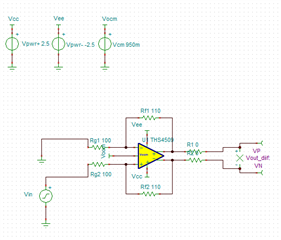
differential signal using the THS4509 and then connect it to an ADS5294 ADC.
Is it possible to achieve a full-scale range in the ADC by configuring it as shown in the diagram Above?
If possible, could you please confirm how it should be configured to achieve this?
Hi Harsh,
This device outputs around 1.1V from the supplies, which would mean the max voltage at each output is around 1.4 volts. With this common mode and Vopp the device would have to adjust the outputs resulting in a shifted common mode voltage to accommodate for the lack of headroom. One quick fix if possible is to skew the supplies on the device to give more headroom for the device to fully swing to the 1.45V max required. If skewing the supplies is possible, something like -1.5V to +3.5V would be good as this will ensure the device is operating around mid-supply.
Best Regards,
Ignacio
and scale your R values up, that is heavy load to the FDA outputs, maybe more in the 300ohm Rf region, also add at least series output RC to the ADc
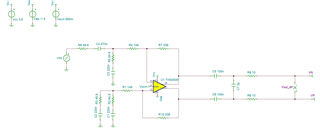
According to this circuit i'm not getting 2Vpp as per 2.22 gain setting
for Recheck
Input AC coupled supply Freq 3.5Mhz and Amplitude is 450mV
can you please provide appropriate value for my application.
Hi Harsh,
At the higher frequencies, the capacitors to ground will behave like a short and the 65ohm and 50ohms in parallel will add to Rg resulting in a lower signal gain. I was able to adjust the circuit and have attached it below to get 2Vopp.
Best Regards,
Ignacio
Thanks ignacio for the support,
but my input is a 0.9Vpp so i think my amplitude should be 450mV in input source.
Can you please provide with this input.
Best regards,
Harsh
Hi Harsh,
The addition of the matching circuit from the original causes an additional voltage divider so I increased the overall gain to around 4V/V to account for the six db attenuation while keeping the same input signal. Attached is the TINA file.
Best Regards,
Ignacio
Hello Ignacio,
I have one more question on this, can i replace THS4509 with THS4551 part if YES,
can you please provide simulation file as per my previous requirement,
Best Regard,
Harsh
Hi Harsh,
I would recommend staying with the THS4509 as the THS4551 is likely to slow for this fast of an ADC. The ADC EVM implements the THS4509 in its design because it has the speed to drive this device appropriately.
Best Regards,
Ignacio
Hello Ignacio,
I'm staying with the THS4509 for my design, but I just want to understand the working and function of the THS4551 with ADS5294 for my knowledge. So, could you please provide a simulation for my previous requirement with the THS4551?
Best Regards,
Harsh
Hi Ignacio,
We add a ADS5294 Input model in the THS4509 simulation that you provide us after the simulation 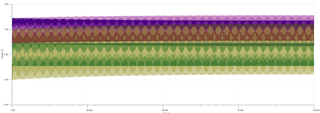
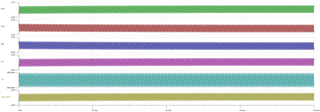
Above is the output signal with ADS5294 Input model,
But why in this i'm seeing a shifting in differential output in Vout_ADC point ?
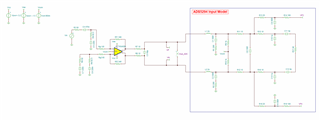
Above is the simulation circuit with ADS5294 input model
I have one more question If i set the power supply +3.3V and -1.8V for THS4509 so is its okay for this part because in datasheet recommended operating is giving MAX 5.25V. So is its okay to use +3.3V and -1.8V for THS4509 as same circuit,

Best Regard,
Harsh
Hi Harsh,
I was not able to simulate the additional input stage model, but it could be from the simulation trying to reach a steady state with the addition of the capacitors at the output and charging up. For the supplies, having a 5.1V total supply should not be a problem as it is still in the recommended supply range. I was able to adjust the circuit for the THS4551 and attached an example circuit.
Best Regards,
Ignacio
Hi Ignacio,
Thanks for providing an example circuit of the THS4551.
I will wait for your simulation circuit with the addition of the capacitor at the output and charging up.
Best regards,
Harsh
Hi Harsh,
Sorry for the confusion, just to clarify when I tried adding the additional stage the simulation would break. I assume the simulation could not find an appropriate bias point and could not converge. Is the output value you are seeing, correct? In terms of the amplitude and frequency of the signal. Ignoring the slight shift.
Best Regards,
Ignacio
Hi Ignacio,
The output value is correct that is 2Vpp, and the input supply Amplitude should be 450mV and frequency range should be 3.5MHz o 10MHz.
Best Regards,
Harsh
Hi Harsh,
The output drifting slightly might be due to the circuit reaching a steady state with all the added capacitors in the circuit. In the ADC this will likely not be happening as it will constantly be sampling, and it will not be a static circuit like the one being simulated.
Best Regards,
Ignacio
Hi Ignacio,
So I can ahead with THS4509 fully working simulated circuit for my design right ?
And can you provide me your recent simulated circuit ?
Best Regards,
Harsh
Hi Harsh,
The simulated file I previously sent is the latest version I have. I would also like to highlight the ADS5294EVM as a reference. The EVM includes the THS4509.
Best Regards,
Ignacio
Hi Harsh,
The slight change at the output seems to be from the added components which will not perfectly model the ADC when it is sampling. We always recommend system level testing as simulations will only show so much and can often show behaviors that will not appear in the real system.
Best Regards,
Ignacio